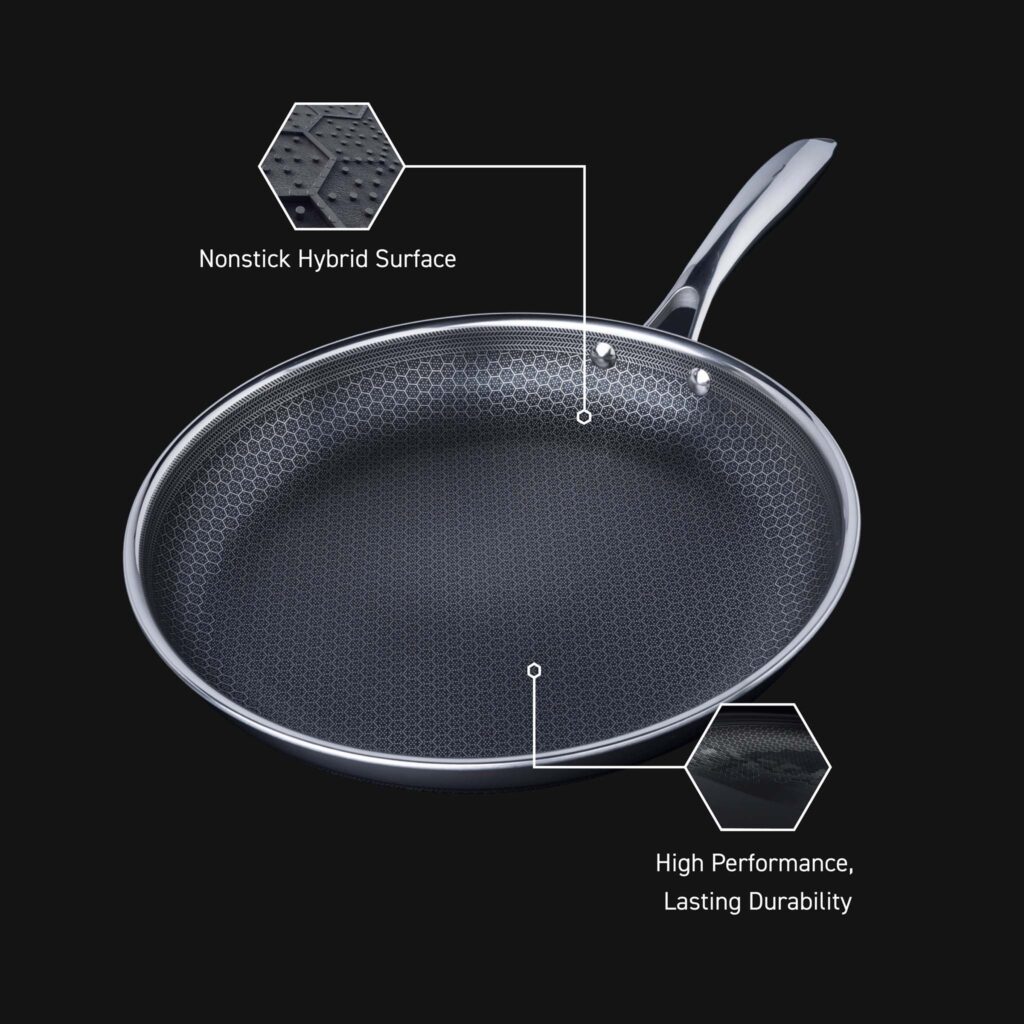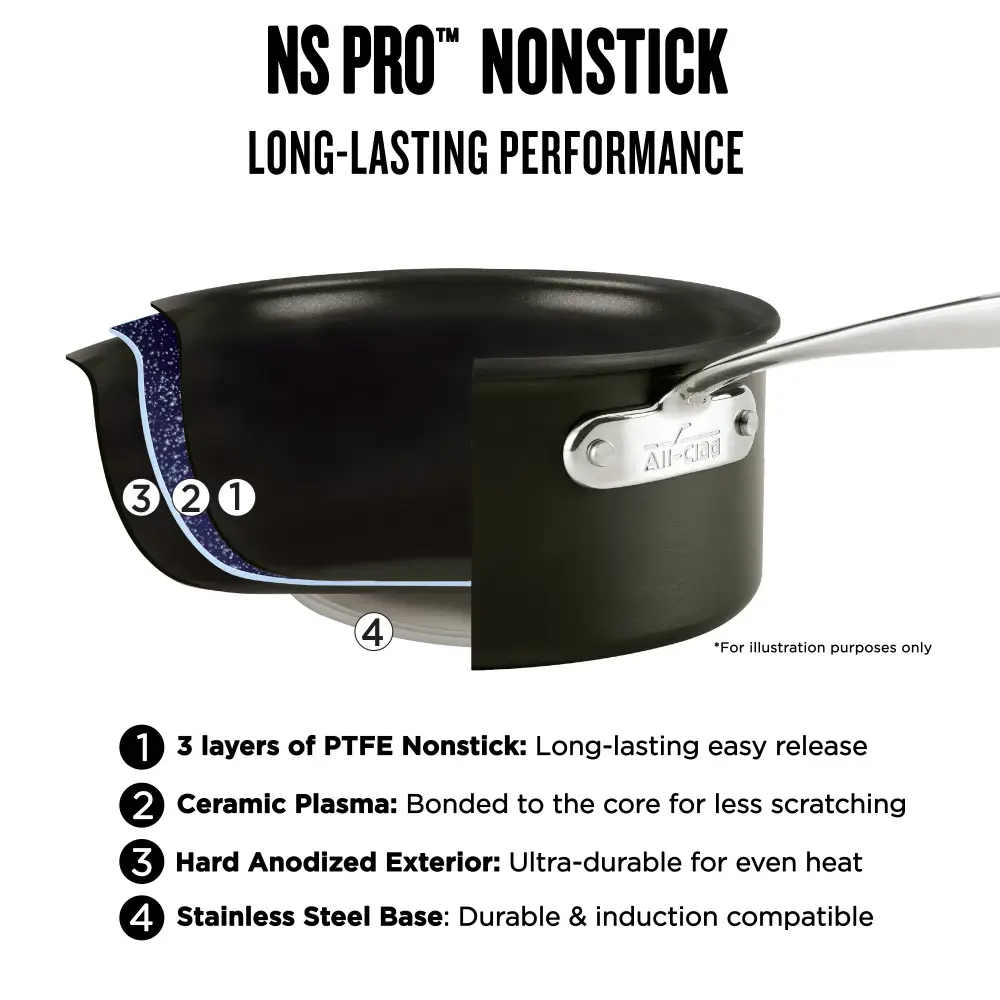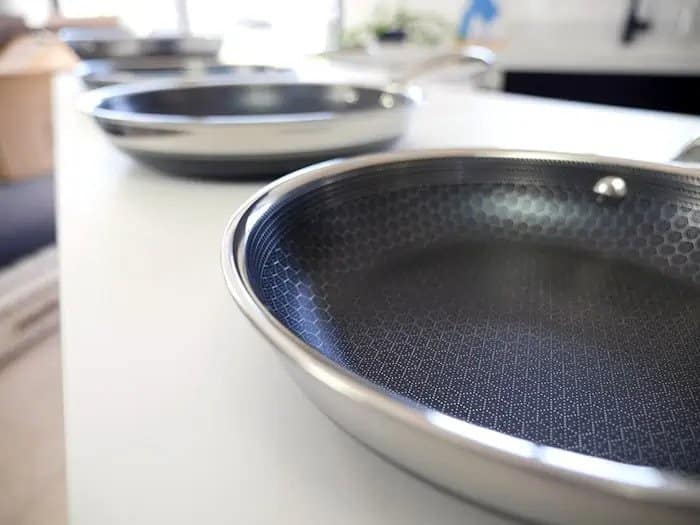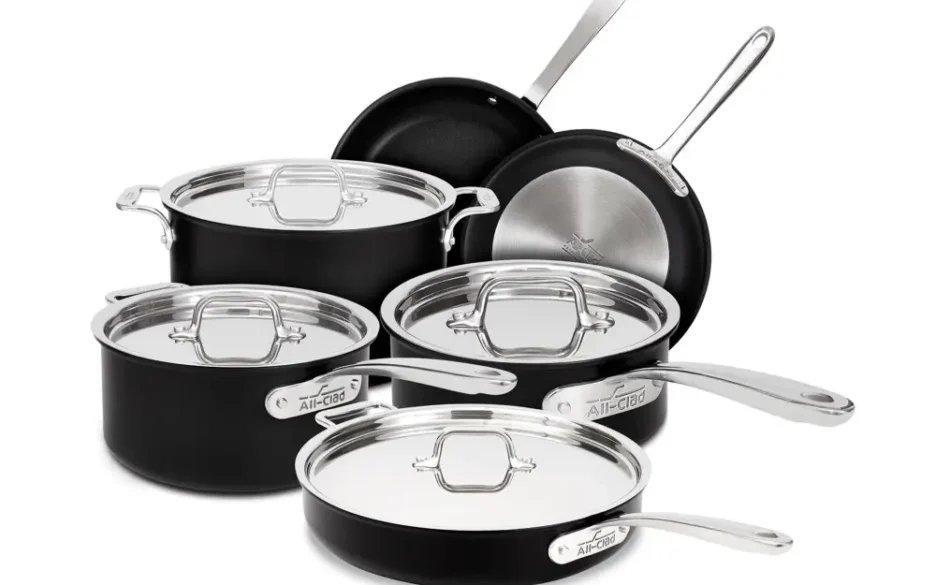All-Clad and HexClad are easy to confuse on name alone. These two cookware brands also have a lot in common in terms of design and materials. In the Sustainability Showdown – HexClad vs. All-Clad – which cookware is best?
There’s a lot to consider when choosing the perfect pan. From performance to durability, appearance to versatility – your priorities may be quite different from someone else’s.
I’m going to assume, though, that because you’re reading Leaf Score, you have at least some interest in sustainable, non-toxic cookware.
These two factors are often overlooked when it comes to non-stick cookware choices. Especially when splashy marketing makes newcomers like HexClad look very appealing.
We put HexClad and All-Clad non-stick head to head, then dive deeper into these two brands and how they fare for performance, durability, eco-friendliness and safety.
Head to Head – All-Clad vs. HexClad
| All-Clad | HexClad | |
|---|---|---|
| Materials | Stainless steel with aluminum core, PTFE coating, some hard anodized aluminum (plus non-stick PTFE) | Aluminum core, stainless steel above and below, PTFE surface with diamond dust |
| Handles | Stainless steel, stay-cool | Stainless steel, stay-cool |
| Helper handles | Yes | Some designs |
| Non-stick coating | PTFE | PTFE with stainless steel lattice |
| Lids | Stainless steel, glass | Glass and stainless steel |
| Third-party testing available | No | No |
| Free from | No claims made | No claims made |
| Leach testing results | Not available | Not available |
| Made in | China, US (depending on collection) | China |
| Oven safe | Yes, varies | Yes, to 500 F (but I wouldn’t risk it, personally) |
| Induction compatible | Yes (most) | Yes |
| Dishwasher safe | Supposedly (see lawsuit note) | Yes |
| Price for 8-inch fry pan | $50-$180 | $140-$160 |
| Warranty | Lifetime (but doesn’t cover normal wear and tear to non-stick surface) | Lifetime warranty (but not for the non-stick surface) |
| Packaging | Unknown | Unknown |
| Sustainability initiatives | None known | None known |
HexClad – a closer look
- More durable non-stick PTFE surface protected by stainless steel lattice
- Metal utensil safe (though still best to avoid these)
- Dishwasher safe (though still best to hand wash)
- Oven-safe to 500 F (though best not to use in the oven)
- Excellent heat distribution
- Works with induction cooktops
- Made with PTFE
- More expensive than most PTFE pans (albeit aluminum body pans)
- Limited range of cookware
- No toxicity testing available
- Hard to see when the PTFE surface is damaged
- Some users find the lattice means the pan isn’t actually non-stick.
HexClad offers non-stick pans for everyday frying. In theory, the design of HexClad should make it easy to fry an egg, fragile fish, tofu, etc., and to braise and sear a steak. In practice, many HexClad users report difficulties with the hexagonal lattice design and food getting stuck to the stainless steel grid.
HexClad promises both non-stick functionality and the cooking prowess of stainless steel. Whether it delivers on those is questionable.
Essentially, if you can make HexClad work for you, you’ll probably love it. But if you can’t quite figure out how to use the non-stick, you’ll have paid a chunk of money for a hulking great pan that is more toxic, less useful, and less durable than a basic stainless steel frying pan that doesn’t feature PTFE.
All-Clad non-stick cookware – A closer look
- Time-tested brand known for quality and durability
- Many pans are made in America
- Excellent heat retention and distribution (for 3-ply and 5-ply pans)
- Offers precision control of temperature
- Wide range of pot and pan styles and sizes, plus specialized pieces
- (Brand also offers PTFE-free stainless steel and cast iron cookware)
- More expensive than many other brands, including HexClad
- No PTFE-free non-stick options
- Not as ‘dishwasher safe’ as All-Clad would like us to think
- Lifetime warranty doesn’t cover normal wear and tear (including to PTFE non-stick)
Culinary enthusiasts will likely love the exceptional heat retention and heat distribution of All-Clad’s non-stick pans. This cookware is also more durable than most non-stick cookware (whether made with PTFE or ceramic).
The design of the All-Clad pans allows for much greater precision and control of cooking, so you can sear, braise, and simmer easily. You can also better prevent overheating of the pans, which is essential so as not to degrade the PTFE coating.
The same goes, of course, for the PTFE-free pans from All-Clad, which have a loyal following due to their robust construction, appearance, and performance.
Which All-Clad products contain PTFE?
Several All-Clad products feature PTFE coatings, with no PTFE-free non-stick options available from the cookware brand. The non-stick PTFE pots and pans also likely contain perfluoroalkoxyalkane (PFA) and fluorinated ethylene propylene (FEP), according to All-Clad’s legal disclosures.
The PTFE products include, but may not be limited to, All-Clad’s following collections:
- NS1 Nonstick
- NS Pro Nonstick
- HA1 Nonstick
- HA1 Curated
- Essentials Nonstick
- Copper Core Nonstick
- D3 Stainless Nonstick
- D5 Stainless Nonstick.
Personally, I would avoid all of these products and look instead for All-Clad pots and pans that are not non-stick and are PTFE-free. Use a bit of oil on the stainless steel or cast iron and they’ll be effectively non-stick. They’ll also last a lot longer and don’t have the same detrimental impact on the environment or on your indoor air quality.
Which All-Clad products are PTFE-free?
Not all All-Clad products are coated with PTFE. The following multilayer stainless steel cookware items do not have non-stick PTFE coatings:
- D3 Stainless
- D5 Stainless
- D3 Everyday
- D3 Curated
- D7 Stainless
- G5 Graphite Core.
If an All-Clad product says it is non-stick, it has a PTFE coating.
All-Clad does not currently offer non-stick ceramic coated pots and pans. Product descriptions can be a bit confusing, however, with All-Clad using ‘ceramic plasma’ as a midlayer between the PTFE and the metal pan core.
Don’t let this fool you. All-Clad non-stick pans are all non-stick thanks to PTFE, not ceramic coatings.
Materials – HexClad vs. All-Clad
All HexClad pans appear to have a 3-ply stainless steel body consisting of two layers of stainless steel and an inner aluminum core. The surface coating is PTFE, topped with a stainless steel lattice.
Several All-Clad PTFE pans comprise an aluminum body and a 3-ply stainless steel base for induction compatibility and heat distribution and retention. Some of the All-Clad PTFE pans have a 3-ply or even 5-ply stainless steel body. This makes them much more robust than most coated aluminum pans and similar to HexClad’s construction (minus the lattice).


All-Clad also offers some PTFE-free stainless steel pans made with the same 3-ply stainless steel body just minus the toxic coating. These are All-Clad’s most sustainable, least toxic pans with the greatest longevity, in addition to the brand’s cast iron pans.
All-Clad vs. HexClad – Durability and Longevity
Sustainability isn’t just about how a pan is made and with which materials. It also encompasses durability and longevity. After all, needing to replace a pan every year or so means using many more resources (materials, energy for manufacture and disposal, and shipping-associated resources).
HexClad’s unique lattice design promises exceptional durability. The company claims the PTFE surface is scratch-resistant but with the lattice over top it’s hard to really tell if the non-stick surface is damaged.
All-Clad non-stick pans don’t have the same stainless steel lattice to protect the PTFE, but they do seem to hold up well even to metal utensils and the dishwasher. That said, a lawsuit filed against All-Clad for its ‘dishwasher safe’ cookware suggests some serious issues with durability.
A class action against All-Clad alleged that the company advertised its pans as dishwasher safe when, in fact, the pans developed sharp edges/rims and thinning with dishwasher use.
All-Clad settled the case, meaning no trial or public examination of evidence. The case included D3, D5, and LTD collections from All-Clad, for products sold from 2015 through to 2022 (and potentially beyond, as it’s not clear All-Clad changed its manufacturing practices).
The upshot of the class action is that it’s probably best to hand wash All-Clad pans. The same is true of HexClad pans, though, given that dishwashers can quickly degrade any non-stick surface coating.
Either way, all PTFE degrades over time. That means both HexClad and All-Clad non-stick pans will likely lose their non-stick properties and need replacing in just a few years.
In contrast, All-Clad’s solid stainless steel pans without PTFE can last for many years, if not decades. There’s no need to worry about scratching off surface coatings or releasing toxic fumes with high heat.
In short, durability varies depending on the All-Clad collection. The stainless steel cookware range without PTFE will last a lot longer than the pots and pans with PTFE.
Manufacturing processes
Manufacturing processes also matter when it comes to sustainability.
We’ve already talked about the inherent unsustainability of PTFE, but it is worth noting that All-Clad has a solid reputation for manufacturing quality cookware.
All-Clad also makes most of its cookware in the US, using American steel. And it does so under ethical working conditions while adhering to more stringent environmental regulations than HexClad, which makes its cookware in China.
US manufacture also means a lower overall environmental footprint, with shorter shipping distances.
Energy efficiency is often overlooked when choosing more sustainable cookware. The design and materials of both HexClad and All-Clad pans translates to efficient heat distribution, but HexClad seems to take a little longer to heat up than All-Clad.
The energy savings with All-Clad are likely marginal, however, and likely won’t be a deciding factor in any choice between the two brands.
Price – All-Clad vs. HexClad
If you’re set on a higher quality non-stick pan made with PTFE, there’s not a lot between All-Clad and HexClad in terms of price. For a good quality 8-inch frying pan made with a 3-ply stainless steel body, you’re looking at paying around $170 from either brand in 2024.
All-Clad also offers cheaper pans that are PTFE coated aluminum for around $50. These less robust pans will likely need replacing even faster than the 3-ply PTFE pans, though, making them more expensive in the long-term.
Overall, All-Clad may work out slightly more cost efficient, but only for the PTFE-free pots and pans, not the non-stick All-Clad offerings. The PTFE-free pans have been tried and tested over many years, with All-Clad enjoying a well established reputation for quality and longevity.
HexClad is still a newcomer, so it’s hard to know how long these pans can last. It also doesn’t offer PTFE-free pots and pans.
Are HexClad and All-Clad PFOA-free or PFAS-free?
Neither HexClad nor All-Clad non-stick pans are PFAS-free. Anyone who says otherwise doesn’t understand the difference between PFAS and PFOA or is being deliberately misleading.
Both HexClad and All-Clad use PTFE as a surface coating for their non-stick pans. PTFE is a PFAS (per- and polyfluoroalkyl substance).
Neither HexClad nor All-Clad are made with perfluorooctanoic acid (PFOA). This chemical, which is used to apply PTFE as a surface coating, has long been banned in the US for use in cookware.
Unfortunately, PTFE still requires some kind of chemical to stick it to the metal body of a pan. And the replacements for PFOA have even less safety information available and may well be just as or more toxic.
In contrast, All-Clad’s stainless steel pans and pots without PTFE are inherently safer, as they don’t rely on non-stick coatings.
Final thoughts on All-Clad vs. HexClad
When it comes to sustainability and toxicity, All-Clad is the clear winner, at least for its PTFE-free stainless steel cookware.
A head to head of the non-stick All-Clad and HexClad sees All-Clad come out on top for its 3-ply and 5-ply pans. This is largely thanks to a solid reputation for quality and longevity, more ethical manufacturing processes, and overall sustainability.
There’s not a lot in it, though, and All-Clad’s aluminum (not uncoated stainless steel) non-stick pans are definitely less desirable than HexClad’s more robust pans.
Overall, if sustainability and toxicity are concerns, choose All-Clad’s PTFE-free stainless steel collections (or, better still, one of our top picks for non-toxic cookware).
However, if non-stick convenience is paramount and you like the lattice look, HexClad is a viable choice, albeit with all the usual caveats regarding toxicity and sustainability.

